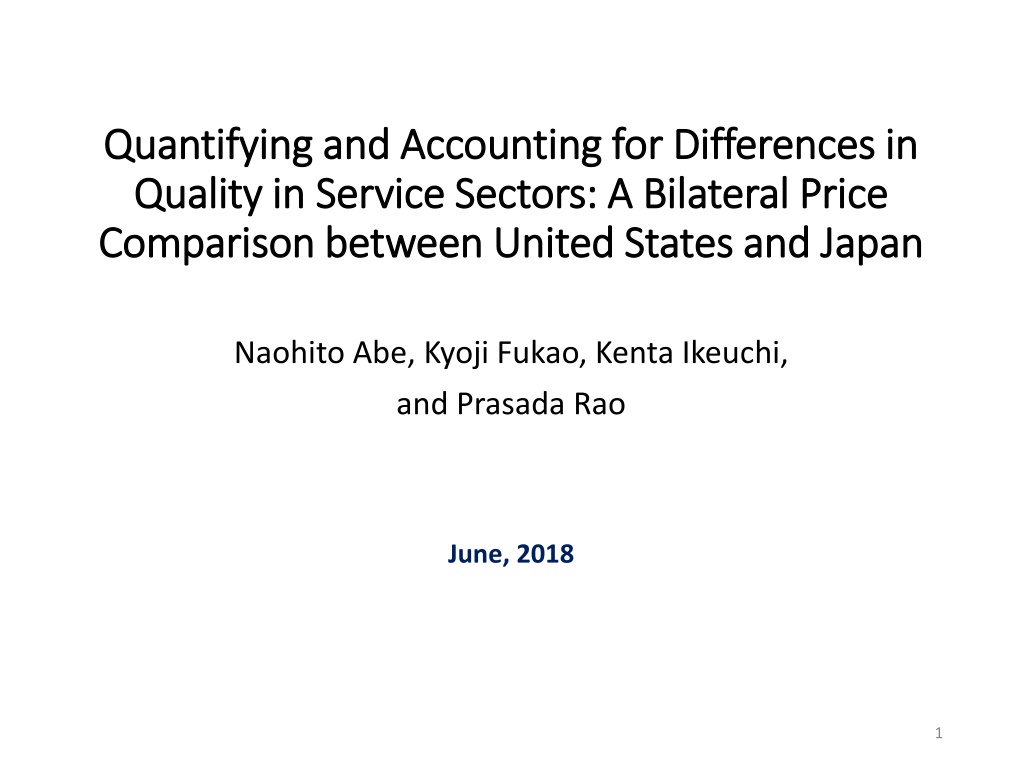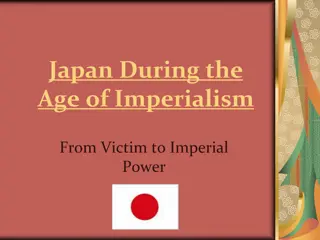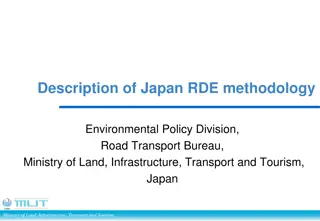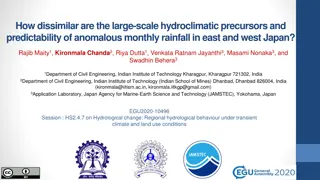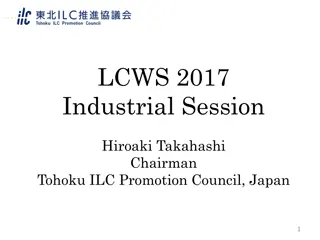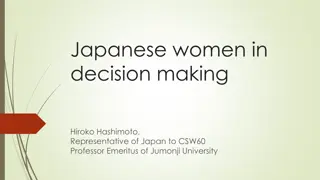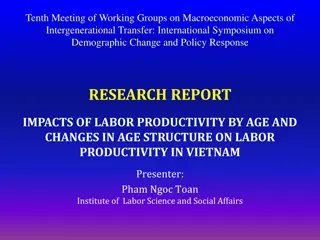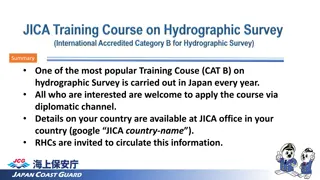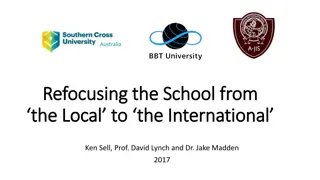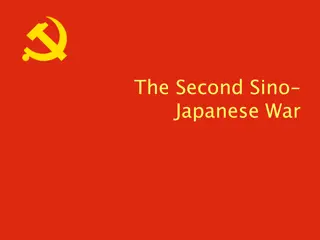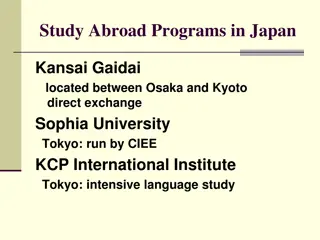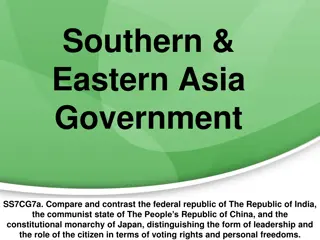Comparing Quality and Productivity in the Service Sectors of USA and Japan
This study delves into the comparison of quality and productivity between the service sectors of the United States and Japan. It examines the role of quality differences in accounting for productivity variances and explores the significance of Purchasing Power Parities (PPPs) in international comparisons. Key points include productivity analysis, the importance of PPPs from the International Comparison Program (ICP), and challenges in measuring quality and comparability.
- Quality Differences
- Productivity Analysis
- Purchasing Power Parities
- Service Sectors
- International Comparisons
Download Presentation

Please find below an Image/Link to download the presentation.
The content on the website is provided AS IS for your information and personal use only. It may not be sold, licensed, or shared on other websites without obtaining consent from the author. Download presentation by click this link. If you encounter any issues during the download, it is possible that the publisher has removed the file from their server.
E N D
Presentation Transcript
Quantifying and Accounting for Differences in Quantifying and Accounting for Differences in Quality in Service Sectors: A Bilateral Price Quality in Service Sectors: A Bilateral Price Comparison between United States and Japan Comparison between United States and Japan Naohito Abe, Kyoji Fukao, Kenta Ikeuchi, and Prasada Rao June, 2018 1
Motivation There are two reasons for this study: PPPs from the International Comparison Program and quality differences Do quality differences in the services sector account for productivity level differences between USA and Japan 2
Productivity of Japanese Service Sector Relative to USA PPP based value added per hour worked: Japan/US, 2005 0.8 0.7 0.6 0.5 0.4 0.3 0.2 0.1 0 Other production Goods producing, excluding Electric machinery, post and Market economy Trade Personal services Transport and storage Total industries Finance and business, except real communication services electrical machinery estate Source: Inklaar and Timmer (2008) 3
PPPs from ICP PPPs from ICP play a central role in international comparisons of prices and real expenditures. ICP-PPPs are also used in output and productivity comparisons levels in different countries. PPPs are essentially spatial price index numbers used in measuring price level differences across countries or geographic regions within a country 4
PPPs from ICP An important consideration in the compilation of PPPs within ICP is comparability comparing prices of products which have the same characteristics. Comparability is achieved through the use of structured product descriptions (SPDs) of products. SPD s do not always guarantee that products priced are of the same quality. To the extent SPD s do not capture quality, PPPs do not just capture pure price level differences but also include quality differences. 5
Measurement Issues - 1 When comparing prices in two different countries, selection of commodities to be surveyed is crucial. Ideally, commodities (1) that are representative in all the countries, and (2) that are of exactly the same quality (comparable), should be chosen. There is a trade-off between representativity and comparability . The Big Mac Index satisfies (2), but not (1). 6
Measurement Issues - 2 When commodities to be surveyed are different, usually we need quality adjustment, which complicates the construction of price index to a great extent. ICP adopts Structural Product Descriptions (SPD) to deal with the issue, which to some extent works well for goods, but nor for services. Since the share of service is increasing in most countries, reaches 70% in the US. The exact measurement of PPP for service categories is very important. 7
Quality Differences in Service Industries Most services are not traded over borders. The law of one price generally does not hold. It is very hard to find identical service in two different countries. When we use transportation service by railroad, the quality of train travel might reflect not only the speed to reach the destination, but also reflect: 1) cleanliness; 2) punctuality; 3) safety; 4) frequency of trains; 5) customer service; 6) congestions; and 7) terminal services. 8
This paper We quantify the effects of quality differences in service industry on the PPP by ICP in a bilateral USA-Japan comparison Based on a unique survey conducted both in the US and Japan, we manage to estimate the consumers marginal willingness to pay for quality differences in the two countries. The difference in quality in services in the US and Japan causes undervaluation of Japanese Yen by 9%. The quality adjusted PPP of service industries of Japan/US is 104 JPY, while without adjustment, it is 113JPY. 9
The Structural Product Descriptions (SPD) The selection of commodities to be surveyed is crucial when making price index. We need to find a commodity that is (1) nationally representative in all the countries and (2) of the same quality. Usually, this is impossible for most commodities. The SPD adopted by ICP is based on the checklists used by the Bureau of Labor Statistics (BLS) in its CPI compilation. 10
Table 1.1 SPDs for selected Rice items 110111102 110111103 110111104 Item Code Long-grain rice, not parboiled, WKB Long grain rice, family pack, WKB Jasmine rice, WKB Item Name Well known Well known Well known Brand 0.5 4 6 Minimum quantity 1.2 10 15 Maximum quantity Kilogram Kilogram Kilogram Unit of measurement Long grain, white rice (milled rice) Long grain, white rice (milled rice) Long grain, jasmine, white rice (milled rice) Type Pre-packed; paper or plastic bag High grade Pre-packed; paper or plastic bag High grade Pre-packed; paper or plastic bag High grade Packaging Quality Preparation Milling Share of broken rice Aromatic (fragrant) Enriched Exclude Non-parboiled (uncooked) Non-parboiled (uncooked) Non-parboiled (uncooked) Extra-well-milled Very low (less than 5%) Very low (less than 5%) Very low (less than 5%) No No Yes No No No Premium rice (e.g. basmati rice, jasmine rice), sticky rice, quick cooking rice Brand Premium rice (e.g. basmati rice, jasmine rice), sticky rice, quick cooking rice Brand Basmati rice, sticky rice, quick cooking rice Brand Specify Reference quantity Reference unit of measurement 1 1 1 Kilogram Kilogram Kilogram 11
Table 1.2 Mens Clothing Items Item Code Item Name 110312131 Men's coat, WKB-M 110312101 Men's suit, wool, WKB- M 110312140 Men's suit, wool/mixed fibres, WKB-L 110312104 Men's trousers, cotton/polyester, WKB-L 4 Well Known Low 1 Piece Item sorting code Brand Brand Stratum Quantity Unit of measurement 1 Well Known Medium 1 Piece 2 Well Known Medium 1 Suit 3 Well Known Low 1 Suit Type Men's casual coat Men's classic two-piece Men's classic two-piece Men's trousers for summer or warm weather. 50-65 % cotton, rest polyester Material Cotton, synthetic or mix 100 % wool Wool or mixed fibres (min. 50 % wool) Style Casual, with zip fastener Jacket: single-breasted, Trousers: straight Jacket: single-breasted, Trousers: straight With loops for belt Length Sleeve length Lining Mid-thigh Long Long Long Jacket: full lining; trousers: partial lining; Long Jacket: full lining; trousers: partial lining; No Color Pattern Single color Plain Dark Plain, stripes allowed Dark Plain, stripes allowed Single color Plain Size Exclude Specify Reference quantity Reference unit of measurement Adult medium Adult medium Waistcoat Brand 1 Suit Adult medium Waistcoat Brand 1 Suit Adult medium Brand 1 Piece Brand, material 1 Piece 12
Table 1.3 SPDs for Passenger Transport by Railway Item Code 110731101 Interurban transport, single ticket, 50 km 1 110731103 Interurban transport, single ticket, 250 km 1 Ticket Passenger train 110731104 Urban tram (rail) or tube, single ticket 1 Ticket Tramway, rail or tube Single adult passenger one way, change allowed; domestic trip Same zone, standard distance, up to 120 min 110731105 Urban tram (rail) or tube, monthly ticket 1 Ticket Tramway, rail or tube Single adult passenger monthly ticket (pass); frequent domestic trip Item Name Quantity Unit of measurement Ticket Transportation Type Passenger train One way fare, for adult passenger; domestic trip One way fare, for adult passenger; domestic trip Ticket type Distance 50 km 250 km Time Wednesday 2nd ("regular" if rating does not exist) Survey city Wednesday 2nd ("regular" if rating does not exist) Survey city Class Starting point 1 month, unlimited trips, incl. peak hours Special discounts; special trains with supplements Validity 1 day 1 day 1 trip (60 - 120 min.) Special discounts; special trains with supplements Special discounts; special trains with supplements Special discounts; special trains with supplements Exclude Reference quantity Reference unit of measurement 1 1 1 1 Ticket Ticket Ticket Ticket 13
The SPD by ICP For rice, the selection does not seem to cause serious problems. For clothing, differences in tailoring, brand could cause significant differences in quality. By specifying the name of the brand, we might be able to mitigate the problems. For railway transportation, quality differences in the provision of services, such as the frequency of trains, delays, crimes, accidents, the cleanliness of trains, etc., are not taken into account (Tsukada 2017), which can cause significant biases. 14
How can we account for quality differences in price comparisons? There can be many factors that determine quality . Such factors are usually very hard to identify and measure. Service is a package of various unobservable factors. Ask consumers directly Conduct surveys on consumer preferences 15
Analytical Framework and Index Analytical Framework and Index Number Approach Number Approach 16
The quality adjustment factor 1 The Budget constraint for the representative consumers in country j and k. ? ?=1 ??????= ??, ? = ? ?? ?, Assume ???and ???are different products! Also assume that by using the quality adjustment factor (1 + ???), we can make the two commodities to be identical for consumers. 1 + ??? unit of ??? is identical to 1 + ??? unit of the commodity ? in country k, ??? 17
The quality adjustment factor 2 1+??? 1+?????????= ?=1 ? = ? ?? ?, where ??? ? ? ??? 1 + ??? =??, ?=1 ??? ??? = 1+???. is can be regarded as the quality adjusted price. ??? The quality adjusted quantity,??? ??? , is defined as = 1 + ??????,? = ? ?? ? 18
Consumers Problem ,?2? ??? ,?3? ??? ,..,??? =?? Max: ? ?1? s.t. ?=1 ? The following expenditure function can be derived, ???1? s.t. ? ?1? ? ??? ,?2? ,?3? ,..,??? ;?? = Min ?=1 ,?2? ??? ,?3? ,..,??? ?? We can define the cost of living index (COLI) between countries j and k as, ,?2? ,?2? ,?3? ,?? ,..,??? ,..,??? ;? ? ?1? ? ?1? ???? = ;? 19
Sato-Vartia Index ?????? ?=1 Expenditure share: ???= ?????? ??? ? = ? ?? ? ? j, k: countries, i: item. Then the S-V price comparison is given by ? ?? ??? ??? ??= ????? ?=1 ??? ??? ln ??? ln ??? ??? ??? ln ??? ln ??? ? ? where?? = 20
Sato-Vartia Price Aggregator We use the Sato-Vartia Price Aggregator Sato-Vartia index is commonly used in the literature focusing on quality (or the number of products) differences in cross-country (Feenstra 1994), and business cycles (Broda and Weinstein 2010) welfare comparison Sato-Vartia has several useful properties: (1) the S-V index is exact for CES utility function; (2) satisfies factor reversal test; and (3) the index is multiplicative 21
Decomposition of Expenditure Ratio Thanks to the factor reversal and multiplicity of the Sato- Varita s price index, ? ?=1 ?=1 ?????? ?????? ????? ??????????? ?? ????? ????? ??????????? ?? ?? = ? ?? ?=1 ?? ?=1 ?? ?=1 ?? ??? ??? ??? ??? ??? ??? ??? ??? ??? ??? 1+?????? 1+?????? ? ? = ?=1 ?? ?? ?=1 1+??? 1+??? ? ? ? = ?=1 ?? ?? ?? ??? ??? ??? ??? ? ? ? ? = ?=1 = ?=1 ?=1 = ??????? ???????? ????? Index Quality Adjusted Volume index 22
Measuring the Quality Differences ???: observed prices that do not reflect quality difference ???: premiums reflecting quality attached to commodity i in country j ??? = 1+??? - Quality Adjusted Price Level l = j,k ??? = ??? ??? ??? ??? 1+??? 1+???- Quality adjusted price ratio for item i 1+??? 1+??? - Quality adjustment ratio 23
Premium for quality Define ??? as the premium felt by the household in country k for the commodity i in country j. This implies, if the price of ??? is discounted by 1 + ???, the two commodities become identical. That is, we can obtain, = 1 + ??? ??? ??? ??? ???. 24
Identifications of Quality Adjustment Factor 1 1+??? 1+???. By assumption, 1 + ??? = If the households in two countries have identical preferences, we have, 1+??? 1+???= 1 1 + ??? = 1+???. However, if the preferences are heterogeneous across countries, we need additional subscript, 1+??? 1+??? 1+??? 1+??? 1 = 1 + ???, = 1+???. ? ? 25
Identifications of Quality Adjustment Factor 2 The cost of living index based on the willingness to pay by consumers in countries j and k are respectively given by ? ? ?? ?? ?? ??? ??? ??? ??? 1 ?????= = 1 + ??? ?=1 ?=1 ?? ??? ??? ?? ? ?????= ?=1 1 + ??? Here, we use the geometric mean of the two cost of living indexes as the cost of living index of the two countries, ?? ?? ??? ??? 1+??? 1+??? ? ???? = ?=1 26
The Survey The Survey 27
US-Japan Survey: Quality differences and willingness to pay Survey was supported by funding from the Japan Productivity Center Internet surveys were conducted both in Japan and the United States in February-April, 2017. Sampling 20-60s, reflecting the age-gender distribution in the census. Japanese Sample: From individuals who stayed in the United States at least for a period of three months since April, 2012. Sample size: 519 (479 valid responses) US Sample: Individuals who stayed in Japan for at least one month since April, 2012. (initially imposing staying for three months or longer, but it was very hard to collect enough sample size) Sample size: 517 (404 valid responses) 28
How to Get the Information on the Marginal Willingness to Pay We would like to know the Marginal Willingness to Pay for the quality in both countries. Consumer surveys have been attempted to capture the value of commodities whose prices have not revealed in the market such as clean air or a visit to a national park. We could ask consumers marginal willingness to pay for a very specific service such as a dinner at Sushi restaurant. However, the price of Sushi depends on the contents as well as their side dish. If we specify the contents of a diner, the measure becomes more accurate, however, it is hard to find a consumer who actually knows the value of such dinner. 29
In our survey Rather than obtaining the information on the marginal willingness to pay for a specific item, we try to get the relative marginal willingness to pay, (marginal substitution rate). We try to find consumers who experienced service both in the US and Japan in some specific periods. Such persons are expected to know the differences in the quality between the two countries. After finding such persons, we ask: Suppose services of the average Japanese quality were offered in the US in English. If the Japanese service was better in quality than the corresponding US service, how much more would you be willing to pay for the Japanese service? 30
Service Industry in our Survey 1 Taxi 15 Hotel (mid-range) 2 Rental car 16 Hotel (economy) 3 Automobile repair 17 ATM, money wiring service 4 Subway 18 Real-estate agent 5 Long-distance train 19 Hospital 6 Air travel 20 Postal mail 7 Parcel delivery service 21 Provider with a mobile phone line 8 Convenience store 22 TV reception service using cable, satellite, Wi-Fi, etc. 23Hair dressing/beauty services (including beauty salons) 24 Laundry 9 General merchandise store 10 Department store 11 Coffee shop 25 Travel services Electricity, gas, heat supply, sewerage and water distribution/pipe repairs & management 12 Hamburger restaurant 26 13 Casual dining restaurant 27 Museum/art gallery 14 Hotel (luxury) 28 University education 32
Sample versus Population Sample versus Population characteristics characteristics Japan US Nationwid e Average 46.4 Nationwid e Average 37.6 N mean p50 sd N mean p50 sd Age Househo ld Income Female Ratio Married Family Size Universit y Graduate Exchange Rate 479 44.33 43 12.83 404 35.26 33 9.93 479 977 751 787.33 546 404 105189.9 75074.46 107174.7 53889 479 0.50 0 0.50 0.514 404 0.48 0 0.50 0.508 479 0.70 1 0.46 0.589 404 0.33 0 0.47 0.524 479 3.04 3 1.38 2.38 404 3.17 3 1.52 2.64 479 0.70 1 0.46 0.299 404 0.54 1 0.50 0.205 479 102.92 100 11.99 404 99.90 100 14.54 33
Service Utilization 500 450 400 350 300 250 200 150 100 50 0 Hotel premium TV Hamburger Shop Electricity, Hotel medium Rental Car Parcel Convenience Store Internet Provider Museum/art University Airplane Coffee Shop Casual Restaurant ATM, Hospital Hair Salon Taxi GMS Hotel low Travel Agency Automobile Repair Department Real-estate Postal Laundry Subway/urban Long-distance Railway Japan US 34
Mean Age Differences 50.00 45.00 40.00 35.00 30.00 25.00 20.00 TV Postal Rental Car Hotel low Airplane Parcel Department Real-estate Laundry University Subway/urban Museum/art Convenience Store ATM, Taxi Hamburger Shop Hair Salon GMS Casual Restaurant Hospital Automobile Repair Hotel medium Internet Provider Long-distance Railway Electricity, Hotel premium Travel Agency Coffee Shop Japan US 35
Mean Income Differences (Japan) 1200 1150 1100 1050 1000 950 900 850 TV Postal Rental Car Hotel low Airplane Parcel Museum/art Taxi Subway/urban Department Real-estate Laundry University Convenience Store ATM, Hamburger Shop Hair Salon Automobile Repair GMS Casual Restaurant Hotel medium Hospital Internet Provider Electricity, Long-distance Railway Hotel premium Travel Agency Coffee Shop The Average Income of Japanese who experienced US services. 36
Mean Income Differences (US) 150000 140000 130000 120000 110000 100000 90000 80000 70000 60000 TV Rental Car Hotel low Postal University Museum/art Airplane Parcel ATM, Real-estate Taxi Subway/urban Department Hamburger Shop Laundry Convenience Store Long-distance Railway Casual Restaurant Hair Salon Automobile Repair GMS Hotel medium Hospital Internet Provider Travel Agency Electricity, Hotel premium Coffee Shop The Average Income of US people who experienced Japanese services. 37
Estimation of Quality Difference and Willingness to Pay Two Issues: 1) Questionnaire has responses in intervals converting them to single values Use average of the intervals but poses problems with the final open-ended interval 2) Differences between population and sample characteristics indicates that self-selection could induce biases into estimates We deal with both of these econometrically. 38
Handling Interval and Open Ended Data 1) We ask to respondents about Japan-US relative MWTP for each service as 13 interval categories The first and the last options are open ended We estimate the distribution functions based on for each service and country by the Multimodel Generalized Beta Estimator (MGBE) Utilizing mgbe command in Stata (von Hippel, Scarpino & Holas, 2016) mgbe implements Maximum Likelihood Estimation using 10 Generalized Beta family distributions and uses multimodel inference to obtain estimates from the best fitting models. After getting the best fitted density function (mostly generalized beta), we can calculate the mean value for each interval. We regard the mean as the numeric value for each interval. 2) 3) 4) 5) 6) 40
Curve Fitting to Interval and Open Ended Data Fitted distribution (density) function by the MGBE Frequency of the responses Taking average for each bin. 0.7 0.4 0.5 0.6 0.8 0.9 1.0 1.1 1.2 1.3 1.4 1.5 1.6 Relative WTP for Japan to US service 41
Results for relative MWP to Japanese Services in Japanese, 1 + ????, and US Samples, 1 1+??? 1.30 1.20 1.10 1.00 0.90 0.80 0.70 Taxi Laundry Parcel Hotel low ATM, Postal GMS TV Coffee Hamburger Travel Museum/art Rental Car Subway/urban Air plane Hotel premium Hotel medium Casual Restaurant Real-estate Department Provider Hair University Hospital Automobile Repair Electricity, Long-distance Railway Convenience Store US Japan 42
Selection Biases The sample averages of income and other variables are different from those in the census and other survey. Two types of selection biases might exist 1) Selection to visiting US or Japan 2) Selection to utilizing particular service Unfortunately, 1) is very hard to deal with because of very tiny fraction of US people visit and stay in Japan for more than one month. We control for the second bias using Heckman s selection model. 43
Heckmans Selection Model ? ?| ? = 1 = ? + ?? ?? ???? ? = 1,? = ?(? ) x:female dummy, age and age squared, family size, college graduate dummy z (exclusion variables): purposes of visits, job classes, language fluency, and interaction terms 2Step procedures with Bootstrap standard errors Sectors with Significant (10% level) Inverse Mills Ratio US :Rental Car, Automobile Repair, Subway/urban, Hotel medium, Hotel low, ATM, Hospital, University Japan: Casual Restaurants 44
Estimation of Quality Difference and Willingness to Pay 1) Estimate both OLS and Heckman for each country and sector 2) Use the national average values for the covariates, construct the predicted values 3) If the inverse Mills ratio is significantly different from zero, use the predicted values from Heckman s model, otherwise, use estimates of OLS. 45
Predicted National Average MWP service sectors - Japan/US 1.40 1.30 1.20 1.10 1.00 0.90 0.80 0.70 TV Rental Car Coffee Postal Hotel low University Hair Museum/art Parcel Department Real-estate Laundry Taxi Subway/urban Air plane Travel Convenience Store ATM, GMS Hamburger Casual Restaurant Automobile Repair Hotel medium Hospital Long-distance Railway Provider Electricity, Hotel premium US Japan 46
Sample Average (Without adjustment of Samples) 1.40 1.30 1.20 1.10 1.00 0.90 0.80 0.70 Taxi Laundry Parcel Hotel low ATM, Postal GMS TV Coffee Hamburger Travel Museum/art Rental Car Subway/urban Air plane Hotel premium Hotel medium Casual Restaurant Real-estate Department Provider Hair University Hospital Automobile Repair Electricity, Long-distance Railway Convenience Store US Japan 47
Aggregation Retail Sector PPP We need weights to construct Sato-Vartia index. We use expenditure data by OECD BH 2014 for each service. In the OECD BH 2014 data, household payment to retail services (a part of commerce margin) is included in consumption expenditure of goods. As the weights for retail services, we use the commerce margins based on Input-Output tables for retail industry in both countries. 48
Service Sector Comparisons Main Results with real estate w.o. real estate 113 1.10 1.07 1.08 104 Sato_Vartia_PPP_ICP (US/JPN) RMWTP_Japn_SV RMWTP_US_SV Geometric Mean of RMWTP (JPN/US) PPP Quality Adjusted (US/JPN) Per Capita Quantity Index Based on ICP (JPN/US) Per Capita Quantity Index Quality Adjusted (JPN/US) Total Value Added of Japan (trillion yen) Total Value Added of the US (trillion $) 95 1.09 1.06 1.09 88 0.46 0.33 0.50 0.36 113 5.44 53.1 4.27 Note: Data of PPP and Total Value Added are taken from ICP's tables of Basic Heading 2014. SV stands for Sato-Vartia Index 49
Implication for Japan-US Labor Productivity Gap Value added share in Japan's total GDP Labor productivity, Japan/US US=100 0 20 40 Total = 55.5% Quality adjusted LP, Japan/US LP (Takizawa 2016), Japan/US 118.0 114.1 100 (Labor productivity in the United States 100) 75.3 74.0 121.7 53.9 52.6 93.8 42.8 50 40.6 38.5 71.3 67.2 49.5 43.0 41.5 37.5 33.3 0 Education other business activities Renting of m&eq and trade Wholesale and retail Health and social work telecommunications Post and storage Transport and restaurants Hotels and services social and personal Other community, intermediation Financial We did not make quality adjustment of intermediate inputs and capital stock, output not used for household consumption. 50
